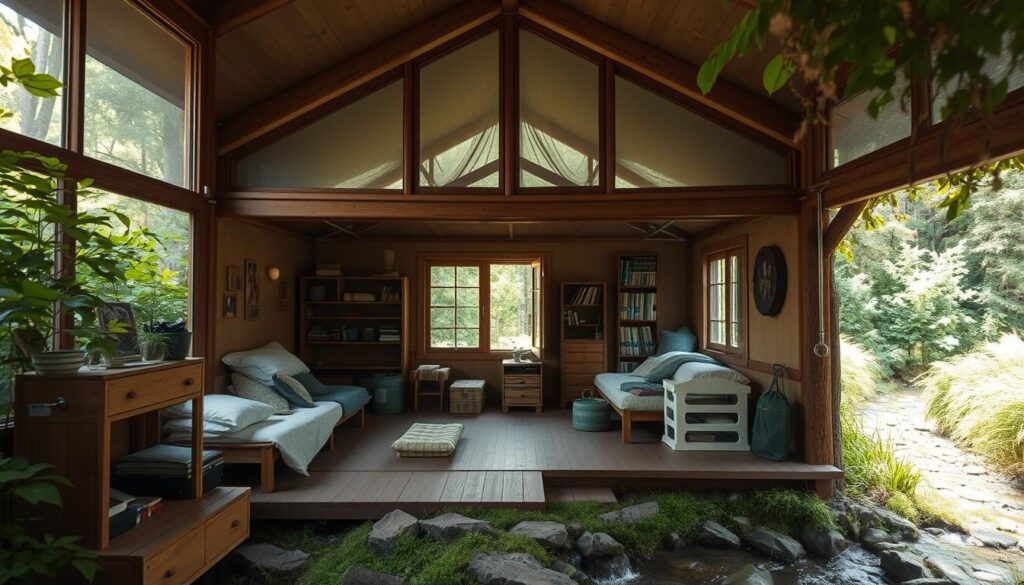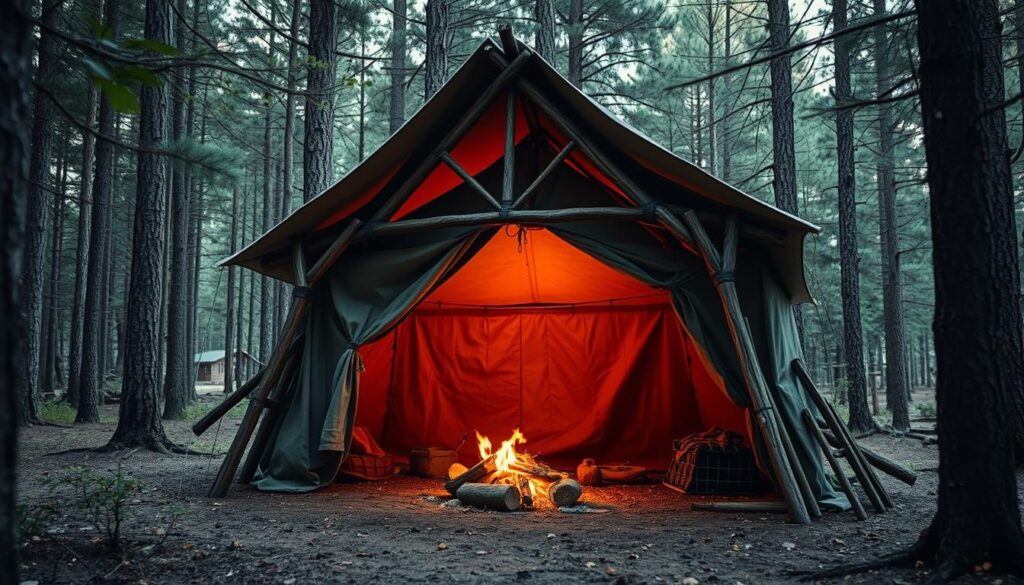Having a safe place when disaster strikes can save lives. It’s key to save energy and stay sharp. A secure spot to recover is a must.
A well-made emergency shelter is vital in tough times. It’s more than just a roof; it’s a protective space. It helps you feel safe and calm again.
In this article, I’ll share my tips on creating a good refuge. We’ll look at the important parts that help in a crisis.
Key Takeaways
- Understanding the importance of a safe haven in crisis situations
- Identifying the key elements of an effective refuge
- Learning how to conserve energy and mental sharpness
- Discovering the benefits of a well-crafted emergency shelter
- Preparing for the unexpected with a reliable crisis shelter
Understanding the Importance of an Emergency Shelter
An emergency shelter is more than just a place to stay. It’s a lifeline during emergencies. Without it, being outside can be deadly. It keeps you safe from rain, snow, wind, cold, and sun.
Definition and Purpose of an Emergency Shelter
An emergency shelter or disaster relief accommodation is a safe place for those hit by disasters. It’s meant to protect you until it’s safe to move again.
Types of Emergencies Requiring Shelters
Many emergencies need shelters, like hurricanes, earthquakes, floods, and wildfires. Man-made crises, like industrial accidents or conflicts, also require them. Knowing what emergencies might happen in your area helps you prepare the right shelter.
| Emergency Type | Shelter Requirements | Key Considerations |
|---|---|---|
| Hurricanes | Wind-resistant shelters, storm-proof materials | Proximity to evacuation routes, safety from flooding |
| Earthquakes | Earthquake-resistant construction, secure anchorage | Accessibility, emergency supplies, backup power |
| Floods | Elevated shelters, waterproofing | Proximity to essential services, water purification systems |
My Personal Experience with Emergency Situations
I once found myself without power for days during a storm. Having a safe emergency shelter was key. It kept me safe and gave me comfort during a tough time.
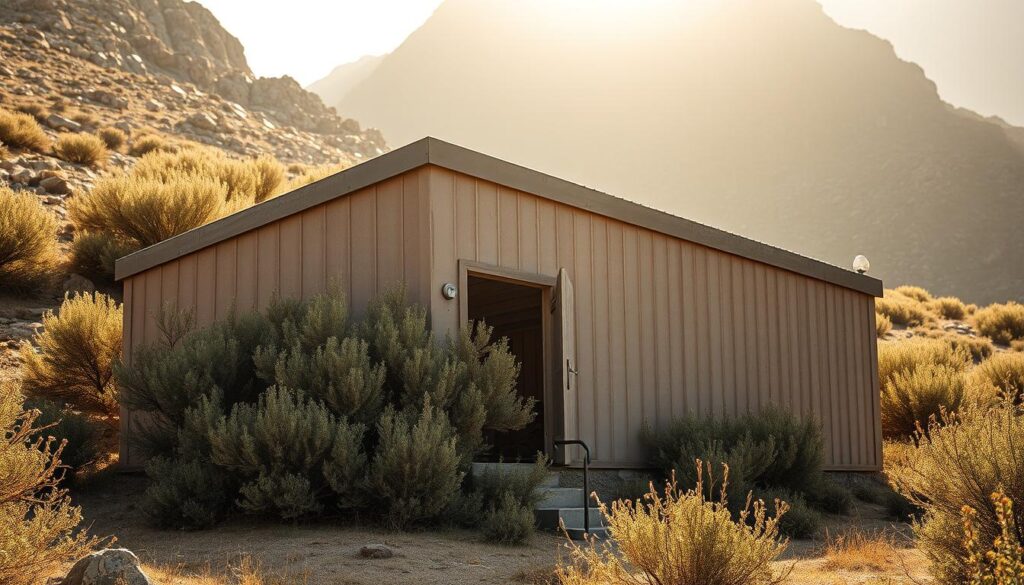
Assessing Your Shelter Needs
Knowing what shelter your family needs is key in emergencies. A good shelter protects you from the weather and other dangers you might face.
Identifying Possible Emergencies in Your Area
First, figure out what emergencies are likely in your area. This could be natural disasters like hurricanes or floods, or man-made ones.
Looking into local emergency trends helps you prepare better. Knowing the risks in your area is important.
Evaluating the Size and Capacity of the Shelter
The size and how many people it can hold are very important. Your shelter should have enough room for everyone to sit or lie down comfortably.
Think about how many people will be in the shelter. Also, remember space for supplies and equipment.
| Family Size | Recommended Shelter Size (sq. ft.) | Essential Supplies to Consider |
|---|---|---|
| 1-2 people | 10-20 | Water, non-perishable food, first aid kit |
| 3-4 people | 20-30 | Additional blankets, flashlights, battery-powered radio |
| 5 or more people | 30-50 | Extra clothing, personal hygiene items, multi-tool |
Considering Special Needs for Family Members
Think about any special needs in your family, like medical needs or mobility issues. Your shelter should meet these needs with the right accommodations and supplies.
For example, if someone uses a wheelchair, the shelter needs to be wheelchair accessible. Or, you’ll need to make other plans.
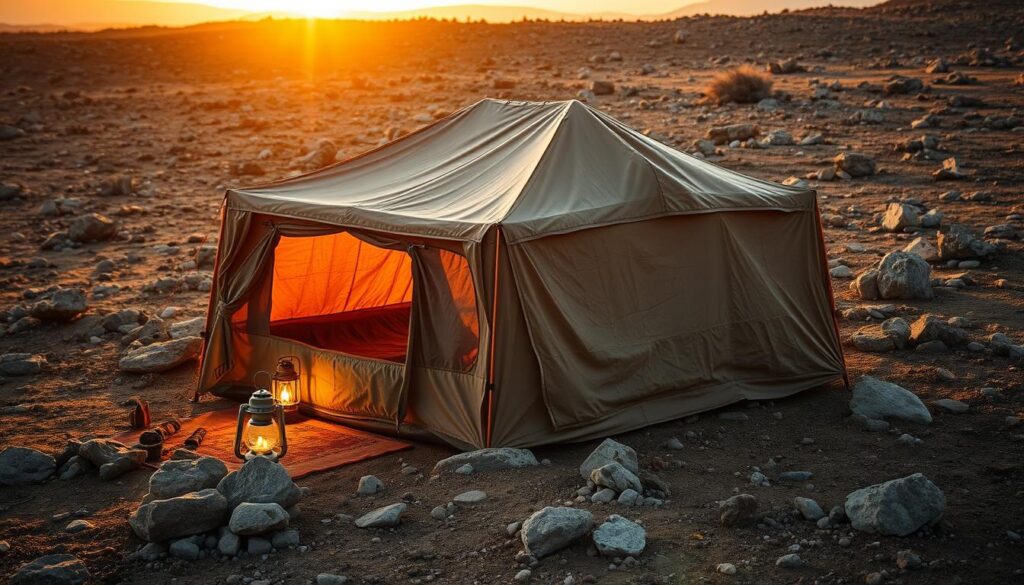
Choosing a Location for Your Shelter
Finding the right spot for an emergency shelter is key. It’s about safety, easy access, and how well it works. These factors are very important.
Think about the Four “W”s: Widowmakers, Wind, Water, and Wood. Widowmakers are dangers like dead trees or branches. Wind direction matters to avoid harsh winds. Being near water is good but can also mean flood risks. The Wood or plants around can show risks or benefits, like wildfires or natural barriers.
Proximity to Essential Services
A crisis shelter should be near medical care, food, and ways to communicate. This helps a lot during emergencies.
Safety from Natural Disaster Risks
Check if the area is safe from disasters like earthquakes, hurricanes, or floods. A shelter should not be in a floodplain or on a fault line unless it’s built to handle it.
Accessibility for Evacuations
The shelter must be easy to get to and from. It should be near safe paths and not blocked by anything. This makes sure people can move in and out safely.
In short, picking a spot for a homeless shelter needs careful thought. By looking at all these points, we can make a safer and better shelter.
Essential Supplies for Your Emergency Shelter
A well-stocked emergency shelter can save lives. It’s key to have the right supplies for you and your family in a crisis. An emergency shelter or emergency refuge is more than a place to stay. It’s a safe space with everything you need to survive.
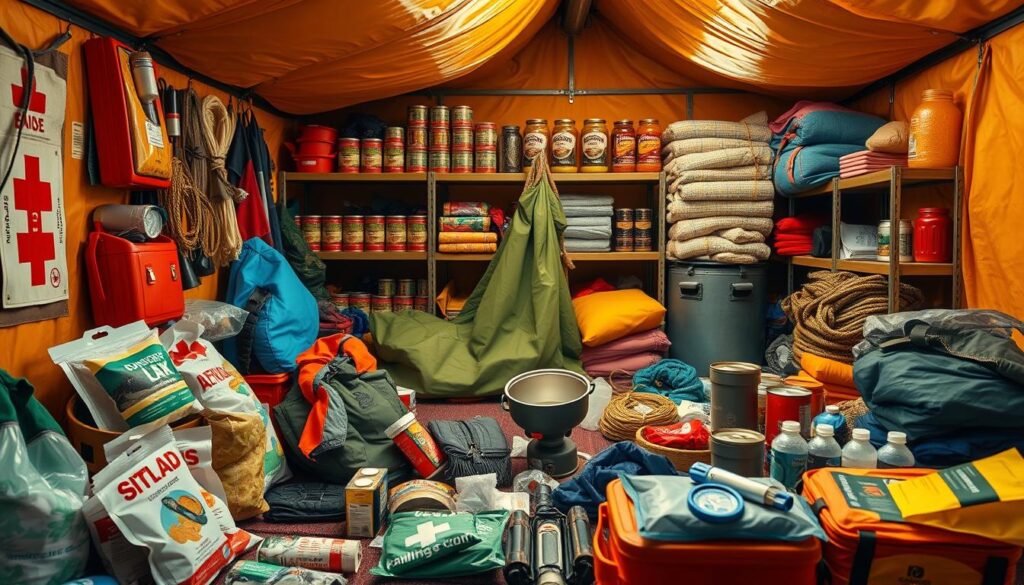
Water and Food Storage Guidelines
Having clean water and non-perishable food is vital in any disaster relief accommodation. Store at least one gallon of water per person per day for drinking, cooking, and hygiene. Choose high-calorie, nutrient-rich foods that don’t need electricity to prepare.
Think about adding a water purification system or filters to your emergency kit. For food, MREs, canned goods, and dried fruits and nuts are great choices. Remember to include a manual can opener too!
First Aid Kits and Medical Supplies
A good first aid kit is key for minor injuries and preventing infections. It should have bandages, antiseptic wipes, pain relievers, and any needed prescription meds. A first aid manual can also be helpful.
Make sure your kit meets your family’s specific medical needs. This might include EpiPens for allergies or supplies for chronic conditions.
Tools and Equipment to Include
There are many tools and equipment that can help in an emergency. A shelter kit, which helps build a shelter fast, usually includes a waterproof sheet and cordage. Other must-haves are a flashlight, extra batteries, a battery-powered radio, and a multi-tool or pocket knife.
Being able to start a fire is also important. This can be done with matches or a lighter. It’s useful for warmth, cooking, and signaling for help if needed.
Designing Your Shelter Layout
Creating an effective emergency shelter layout is key. It helps use space well and keeps everyone comfortable during tough times. It’s important to think about what everyone needs and plan well.
A good shelter layout focuses on using space wisely. This means using furniture that does more than one thing and smart storage. For example, bunk beds with drawers keep things tidy and save floor space.
Maximum Usage of Available Space
To use space well, measure the shelter and plan the layout carefully. Use emergency shelter standards to make sure it meets needs.
Here are some ways to save space:
- Use wall shelves and storage
- Choose foldable or collapsible furniture
- Make a central spot for everyone to gather
Creating Safe Zones within the Shelter
Keeping everyone safe is the main goal. Safe zones in the shelter protect people from dangers. For example, have a special area for dangerous items or a safe room for those who need it most.
Privacy Considerations and Comfort
Privacy and comfort are also important. Having separate spots for sleeping and hygiene helps keep dignity and reduces stress. Adding things like good lighting and air flow makes the shelter more comfortable.
By designing the shelter with these things in mind, you can make a safe, cozy, and useful place. It’s a reliable solution for temporary housing in emergencies, using shelter services well.
Building vs. Utilizing Existing Structures
Emergency shelters can be built from scratch or repurposed from existing facilities. Each option has its own benefits. The choice depends on the emergency type, available resources, and personal preferences.
Advantages of Building a Custom Shelter
Building a custom shelter offers tailored solutions. It can be designed with the exact capacity needed. Features like reinforced structures for safety and specialized ventilation systems for hazardous environments can be included.
Also, a custom-built shelter can be placed in a strategic location. This makes it easy to access during emergencies. But, it requires a big financial investment and planning.
Pros and Cons of Using Temporary Structures
Using existing structures or temporary shelters is a cost-effective and quick option. Tents, inflatable shelters, or repurposed buildings can work well. Yet, they might not offer the customization and security of a purpose-built shelter.
The benefits of temporary structures include rapid deployment and lower initial costs. But, they may not provide the same protection or comfort as a custom-built shelter. Their quality and availability can also vary.
Evaluating Local Resources and Facilities
When choosing between building and using an existing shelter, evaluating local resources is key. Look for shelters in your area, like community centers or schools. These could serve as emergency shelters.
Also, knowing local building codes and construction resources is important. For those with limited resources, using existing structures might be more practical.
Preparing for Long-term Shelter Use
Reflecting on my time in emergency shelters, I see how vital long-term planning is. When setting up a crisis shelter or disaster relief accommodation, think ahead. It’s not just about the start; it’s about the long journey.
For survival over time, planning is key. You need to manage water, food, and medical needs. Efficient resource management is essential for life in a shelter for a long time.
Strategies for Maintaining Resources
To keep resources going, know your shelter’s limits and the needs of those inside. This means:
- Rationing food and water to stretch them as far as possible
- Creating a system for waste and keeping things clean
- Having medical supplies ready and easy to get to
Psychological Preparedness for Extended Stays
Being mentally ready for a long stay in a shelter is as important as having the right stuff. Maintaining mental health is tough, but there are ways to cope.
Try to keep a daily routine, find activities to do, and stay in touch with family. It’s also important to have a plan for dealing with stress and anxiety.
Community Support and Communication Plans
A support network can greatly help during a long shelter stay. This includes family and the wider community. Community support offers emotional and practical help.
Creating a communication plan is critical. It’s about keeping in touch with family and getting updates from outside the shelter.
Training and Drills for Emergency Preparedness
Regular emergency drills are key for good emergency preparedness. They help everyone know what to do in an emergency. This includes practicing how to build a shelter and follow emergency procedures.
Importance of Regular Drills
Drills reveal problems with your emergency plan. They show if you have enough supplies or if your shelter can hold everyone. By doing these drills, you can make your plan better.
For example, you might find your shelter doesn’t have enough ventilation. Or, your family’s communication plan might need work. Fixing these problems can make your family safer.
Engaging Family Members in Planning
It’s important to get everyone in your family involved in planning. This makes sure everyone knows their role. It also helps spot any special needs or concerns.
For tips on making a plan that fits your family, check out this resource. By getting everyone involved, you can make a plan that works for everyone. This makes your emergency shelter or emergency assistance center more effective.
Collaborating with Local Emergency Services
Working with local emergency services is also important. They can share insights on risks and best practices. They can also help you get resources and information to improve your emergency refuge.
For instance, they might teach you how to use emergency equipment. Or show you how to prepare for different emergencies. This can make your emergency preparedness stronger.
Reviewing and Updating Your Emergency Plan
It’s important to regularly check and update your emergency plan. This makes sure it works well to keep you safe. You need to follow a few steps to keep your shelter ready.
Scheduling Regular Evaluations
I always plan to check my emergency shelter often. I look for things that need to get better. This includes making sure the shelter is strong and has all the needed services.
Maintaining Supplies and Resources
It’s key to keep your emergency supplies fresh. I check the expiration dates of food and medicine. I also restock when needed to have enough resources.
Adapting to New Risks
I keep up with new risks and changes in my area. Being ready and updating my plan helps keep my shelter safe. This way, it’s always ready for emergencies.
FAQ
What is the primary purpose of an emergency shelter?
Emergency shelters provide a safe place for people to go during disasters or crises. They help keep individuals and families safe.
How do I assess my shelter needs during an emergency?
First, think about the emergencies that might happen in your area. Then, figure out how big your shelter needs to be. Also, consider the needs of family members, like the elderly or disabled.
What factors should I consider when choosing a location for my emergency shelter?
Look for a spot close to important services. It should also be safe from natural disasters. Make sure it’s easy to get to and from.
What are the essential supplies needed for an emergency shelter?
You’ll need water, food, first aid kits, tools, and other important items. These help people survive during emergencies.
How can I design an effective shelter layout?
Use the space wisely. Create safe areas and think about privacy and comfort. This makes the shelter better for everyone.
Should I build a custom shelter or utilize existing structures?
It depends on your resources, the emergency type, and what you prefer. Weigh the good and bad of each choice carefully.
How can I prepare for long-term shelter use?
Plan for keeping resources going. Get ready mentally for a long stay. Also, set up ways to support each other and stay in touch.
Why is training and drills important for emergency preparedness?
Training helps you and your family know how to act in emergencies. It gets everyone involved and working with local services.
How often should I review and update my emergency plan?
Check and update your plan often. Look at the shelter, supplies, and new risks. This keeps your plan working well.
What is a disaster relief accommodation, and how does it differ from an emergency shelter?
Disaster relief accommodations offer temporary homes after disasters. They’re like emergency shelters but for longer stays and may have more services.
Can a homeless shelter serve as an emergency shelter?
Yes, homeless shelters can be emergency shelters in bad weather or emergencies. But, check if they can handle the emergency needs.
What is an emergency assistance center, and how does it relate to emergency shelters?
Emergency assistance centers give support like food and medical care in emergencies. They might be near emergency shelters for more help.
How can I ensure my emergency shelter is accessible for evacuations?
Think about the shelter’s location and transportation. Make sure it’s easy to get in and out. This helps with safe evacuations.

